Sometimes, the Universe seems bent on hiding the most glorious of events right in plain sight. Just a such an event occurs next week, when the slender waning crescent Moon occults the planet Venus for observers across Europe, the United Kingdom and northern Asia.
Now, the bad news. This event occurs after sunrise on the morning of April 6th, while Venus sits just 16 degrees west of the Sun. The rest of the world will see a very close pairing of the two. New Moon for lunation 1154 occurs at 11:24 UT on April 7th, meaning the Moon will be a slim 2% illuminated crescent during the occultation, just 27 hours prior to New.
Now, seeing such a thin fingernail Moon isn’t impossible; Rob Sparks and Mike Weasner spotted a near-record thin Moon just 13 hours and 48 minutes after New on the evening of January 1st, 2014.
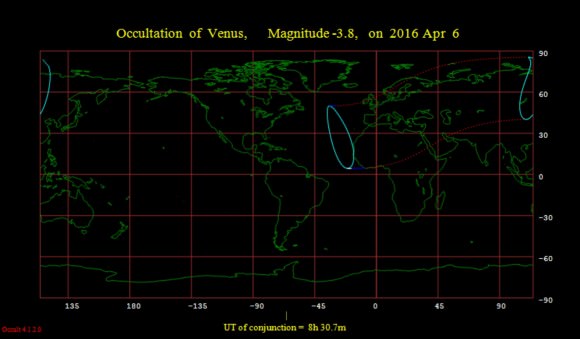
This is occultation 1 of 2 for Venus by the Moon for 2016, and the first of 9 for naked eye planets in the year overall. Unfortunately, this won’t occur under dark skies, like the February 16th, 2016 occultation of Venus for northwestern North America.
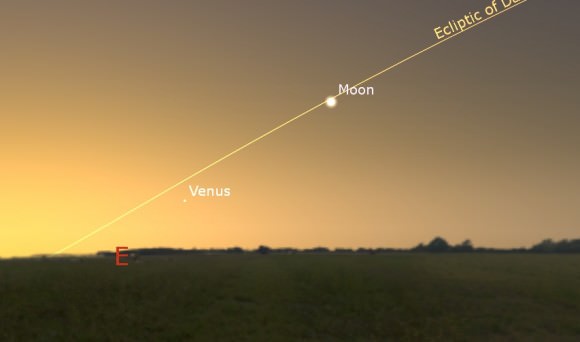
During the April 6th event, Venus is 96% illuminated with a 10” disk, shining at magnitude -3.9. It is possible to see Venus in the daytime, if you know exactly where to look. Ironically, though the visually larger nearby crescent Moon makes a good guide, Venus is actually intrinsically brighter.
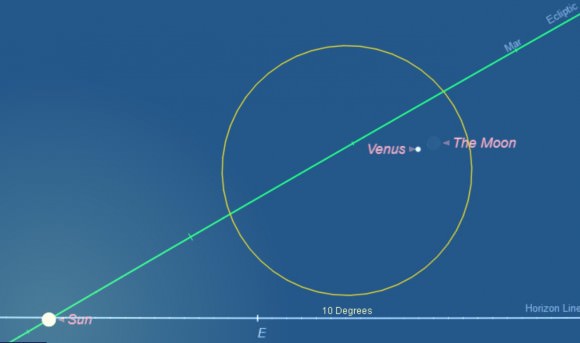
Hunting slender Moons is a fun monthly pursuit. The Muslim calendar is exclusively based on the lunar cycle, and traditionally relies on the first sighting of the waxing crescent Moon to begin a new calendar month. Latitude, the seasonal angle of the ecliptic, and the relative angle of the Moon’s orbit (we’re just now coming off a shallow Minor Lunar Standstill for 2015) all play a role in visibility prospects. For example, a final old Moon sighting on the morning of April 6th favors the Far East westward, while a waxing crescent sighting for the following evening of April 7th favors the Central Pacific westward.
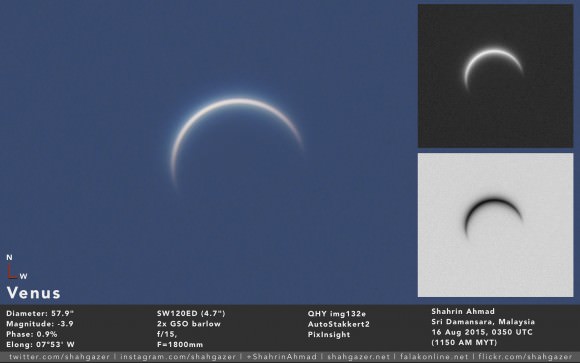
Warning: Of course, the biggest challenge (and danger) while hunting for Venus in the daytime is poised by the nearby glare of our host star, the Sun. Never stare at the Sun (19th century psychologist Gustav Fechner went blind doing just that) and never EVER point unfiltered optics at the Sun, even for a second. Our method is to stand in a spot with the Sun physically blocked far behind a hill or building to begin our search. The deeper blue your skies are, the more likely you are to spot Venus and the crescent Moon. Also, if you can pick up the Moon and Venus just before sunrise, you might just be able to track the pair into the post-dawn, though again, pick your observing site carefully, and keep that Sun blocked from view!
And the farther west you are along the occultation track, the lower the Sun and Venus will be. We’re currently on an extended sabbatical in Europe, and will try for the event ourselves from our current Air BnB basecamp of Jimena de la Frontera in southern Spain. Unfortunately, we’re traveling light and not carrying a telescope in our backpack, but we are carrying our trusty 15x 45 image stabilized binoculars along with our DSLR (which will probably sit idle for the occultation) along with a collapsible tripod.
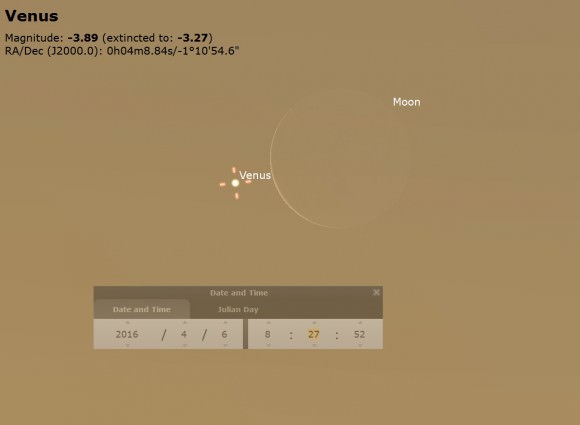
Here’s a sampling of event times from the occultation zone in Universal Time (UT), along with the elevation (altitude) of Venus above the horizon at the time:
Gibraltar (UT +2)
Ingress: 6:47 UT (Elevation: 15.6 degrees)
Egress: 7:48 UT (Elevation: degrees 27.1 degrees)
London: (UT+1)
Ingress: 7:32 UT (Elevation: 20.8 degrees)
Egress: 8:02 UT (Elevation: 24.7 degrees)
Berlin: (UT+2)
Ingress: 7:40 UT (Elevation: 27.8 degrees)
Egress: 8:27 UT (Elevation: 32.2 degrees)
Tel Aviv: (UT+3)
Ingress: 7:30 UT (Elevation: 52.5 degrees)
Egress: 8:57 UT (Elevation: 57.1 degrees)
Malaysian amateur astronomer Shahrin Ahmad observed Venus in the daytime right through inferior conjunction in 2015 (see above). Venus is at an opposite nearly full phase near superior conjunction on the far side of the Sun, and actually passes behind Sol as seen from the Earth for 45 hours in June… a truly impossible observation!
After early April, Venus is just about a goner for morning skies. You can follow Venus as it enters the field of view of the Solar Heliospheric Observatory’s LASCO C3 camera from May 8th to July 5th, and reaches solar conjunction on June 6th. From there, Venus will spend the remainder of 2016 as an evening object. One red letter date to watch for is August 27th, when the planet Jupiter passes just 4′ from Venus low in the evening sky, just 22 degrees from the Sun.
And follow that Moon, as the occultation extravaganza continues into the dusk sky in April. Next on the plate is an occultation of Aldebaran in the current cycle for April 10th for eastern North America, and… wait for it; a rare occultation of an asteroid by the Moon.
Nuff said for now. Tune in next week, as astronomical bodies continue to pass in front of one another, in the drama that is the Universe. More to come!

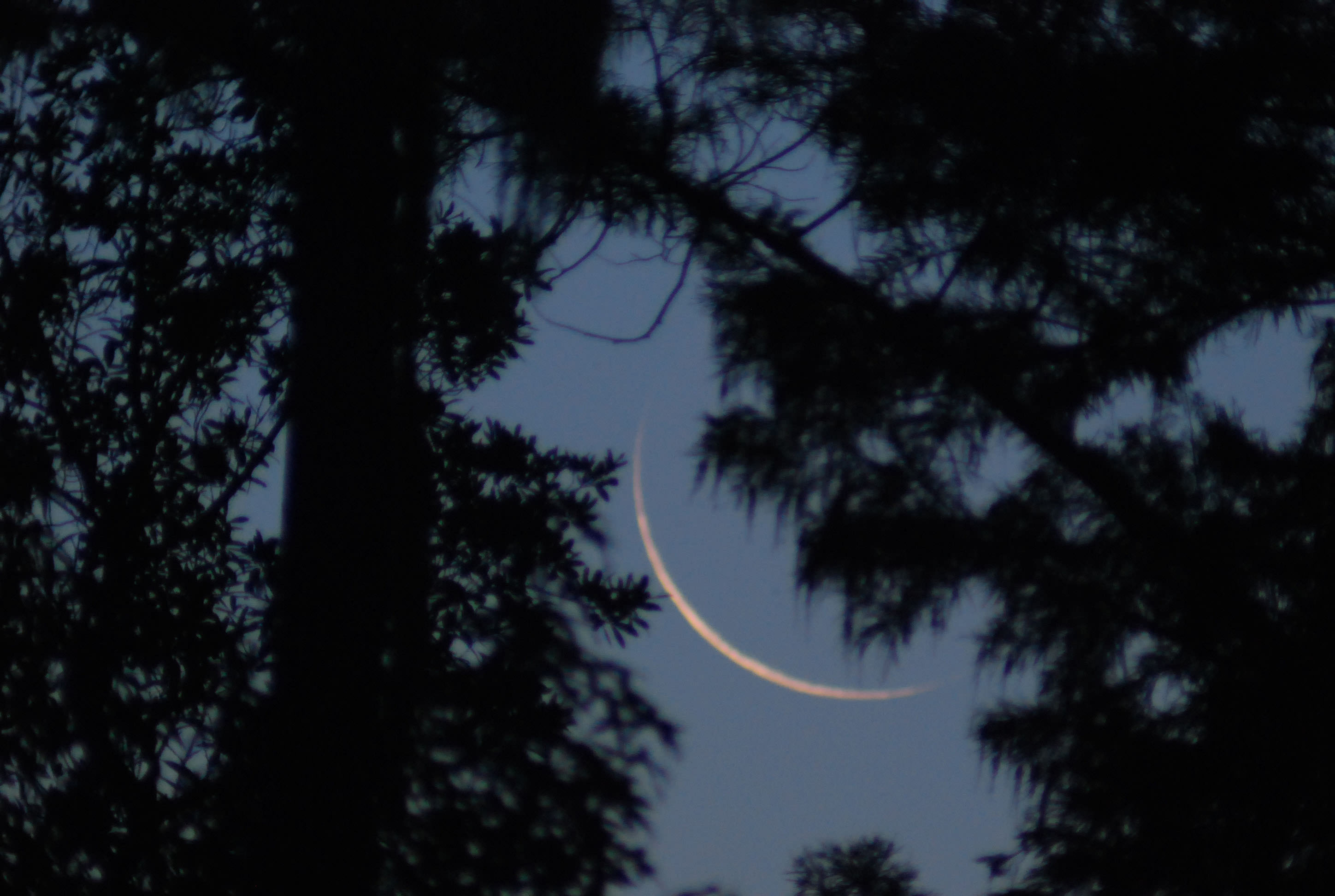
Thanks Dave! I am looking for it for a while. This is a challenge I am willing to accept! I will need to work a location Usually a tall building to completely block the sun from the view. I will need to Think of the gear to use.
Now, here are two options:
1) Remain at home with no building to bock the sun BUT align the EQ6 mount the night before properly so I will be able to find Venus through it easily (And my DSLR camera can be piggybacked on it).
2) Go outside with my portable 70mm refractor and hope for the best….
3) I will also check if the local observatory is doing something.
Anyway here is my video from 2007
Thanks Gadi… I was thinking of you when I put Tel Aviv in the selection of cities. I’ll be watching from southern Spain very near Gibraltar, I can still see Venus each morning. Thinking I’ll probably manage a shot of the thin Moon rising with Venus on April 6th, just before sunrise.